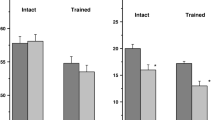Abstract
A sensitizing treatment with 5–10% quinine solution causes short-term (lasting 50–70 min) and long-term (lasting several hours) changes in the activity of the command neurons for defensive behavior (LPl1 and PPl1) in the snailHelix lucorum. The short-term effects are characterized by a depolarizing shift in membrane potential, increased excitability, and an initial increase in the content of bound calcium (Ca-c) in the neurons. The long-term effects appear as facilitation of synaptic components of neuronal responses to sensory stimuli without any changes in excitability and in membrane potential, and also as a repeated increase of Ca-c content. Treatment with anisomycin or cycloheximide during sensitization acquirement prevents development of long-term sensitization.
Similar content being viewed by others
References
I. P. Ashmarin and S. A. Titov, “Modern conceptions about the mechanisms of neurologic memory,”Biol. Nauki, No. 3, 30–43 (1988).
O. A. Maksimova and P. M. Balaban,Neuronal Mechanisms of Behavior Plasticity [in Russian], Nauka, Moscow (1983).
J. H. Byrne, “Cellular analysis of associative learning,”Physiol. Rev. 67, No. 2, 329–439 (1987).
T. J. Carew and C. L. Sahley, “Invertebrate learning and memory: from behavior to molecules,”Annu. Rev. Neurosci. 9, 435–487 (1986).
V. P. Nikitin and S. A. Kozyrev, “Dynamics of defensive and food reactions during the sensitization acquirement inHelix,”Zh. Vyssh. Nervn. Deyat. 41, No. 3, 478–489 (1991).
V. P. Nikitin, S. A. Kozyrev, and M. O. Samoilov, “Involvement of intracellular calcium into the process of sensitization of defensive behavior command neurons inHelix,”Neirofiziologiya 23, No. 4, 418–427 (1991).
V. P. Nikitin, M. O. Samoilov, and S. A. Kozyrev, “Participation of calcium and calmodulin in the mechanisms of sensitization acquirement in Aplysia,”Dokl. Akad. Nauk SSSR 320, No. 1, 236–241 (1991).
E. N. Sokolov and A. G. Ter-Margaryan, “Effect of anisomycin on the synaptic accustoming in the identified neurons of Aplysia,”Zh. Vyssh. Nervn. Deyat. 34, No. 6, 1178–1180 (1984).
L. L. Alkon, B. Bank, S. Naito, et al., “Inhibition of protein synthesis prolongs Ca2+-mediated reduction of K+ currents in molluscan neurons,”Proc. Natl. Acad. Sci. USA 84, No. 19, 6948–6952 (1987).
V. F. Castellucci, H. Blumenfeld, P. Goelet, and E. R. Kandel, “Inhibitor of protein synthesis blocks long-term behavioral sensitization in isolated gill-withdrawal reflex of Aplysia,”J. Neurobiol. 20, No. 1, 1–9 (1989).
V. F. Castellucci, W. N. Frost, P. Goelet, et al., “Cell and molecular analysis of long-term sensitization in Aplysia,”J. Physiol. 81, No. 4, 349–357 (1986).
H. P. Davis and L. R. Squire, “Protein synthesis and memory: A review,”Psychol. Bull. 96, No. 3, 518–559 (1984).
P. Goelet, V. F. Castellucci, S. Schacher, and E. Kandel, “The long and the short of long-term memory — a molecular network,”Nature 322, No. 6078, 419–422 (1986).
T. J. Nelson and D. L. Alkon, “Protein changes underlying long-term facilitation in Aplysia,”BioAssay 11, No. 4, 106–108 (1989).
S. Schacher, V. F. Castellucci, and E. R. Kandel, “cAMP evokes long-term facilitation in Aplysia sensory neurons that requires new protein synthesis,”Science 240, No. 4859, 1667–1669 (1988).
M. O. Samoilov,Brain Neurons Reaction for Hypoxia [in Russian], Nauka, Leningrad (1985).
V. P. Nikitin and M. O. Samoilov, “Chlortetracyclin fluorescent probe is the indicator of calcium ions binding by calcium-binding proteins,”,Biofizika 35, No. 6, 921–924 (1990).
S. Alema, “Calcium and brain proteins,” in:Metal Jens Biological Systems, New York-Basel (1984), Vol. 17, pp. 275–317.
E. T. Walters, “Site-specific sensitization of defensive reflex in Aplysia: a simple model of long-term hyperalgesia,”J. Neurosci. 7, No. 2, 400–407 (1987).
S. A. Kozyrev, V. P. Nikitin, and V. V. Sherstnev, “Selective participation of brain-specific non-histone chromatin Np-3,5 proteins in the recall of defensive habit for food in Aplysia,”Zh. Vyssh. Nervn. Deyat. 41, No. 2, 323–332 (1991).
E. N. Sokolov, “Endoneuronal mechanisms of reinforcement,” ibid.,37, No. 3, 403–407 (1987).
Author information
Authors and Affiliations
Additional information
Translated from Neirofiziologiya, Vol. 25, No. 2, pp. 109–115, March–April, 1993.
Rights and permissions
About this article
Cite this article
Nikitin, V.P., Kozyrev, S.A. Effect of protein synthesis inhibitors on neuronal mechanisms of sensitization inHelix snail. Neurophysiology 25, 93–98 (1993). https://doi.org/10.1007/BF01054156
Received:
Issue Date:
DOI: https://doi.org/10.1007/BF01054156



